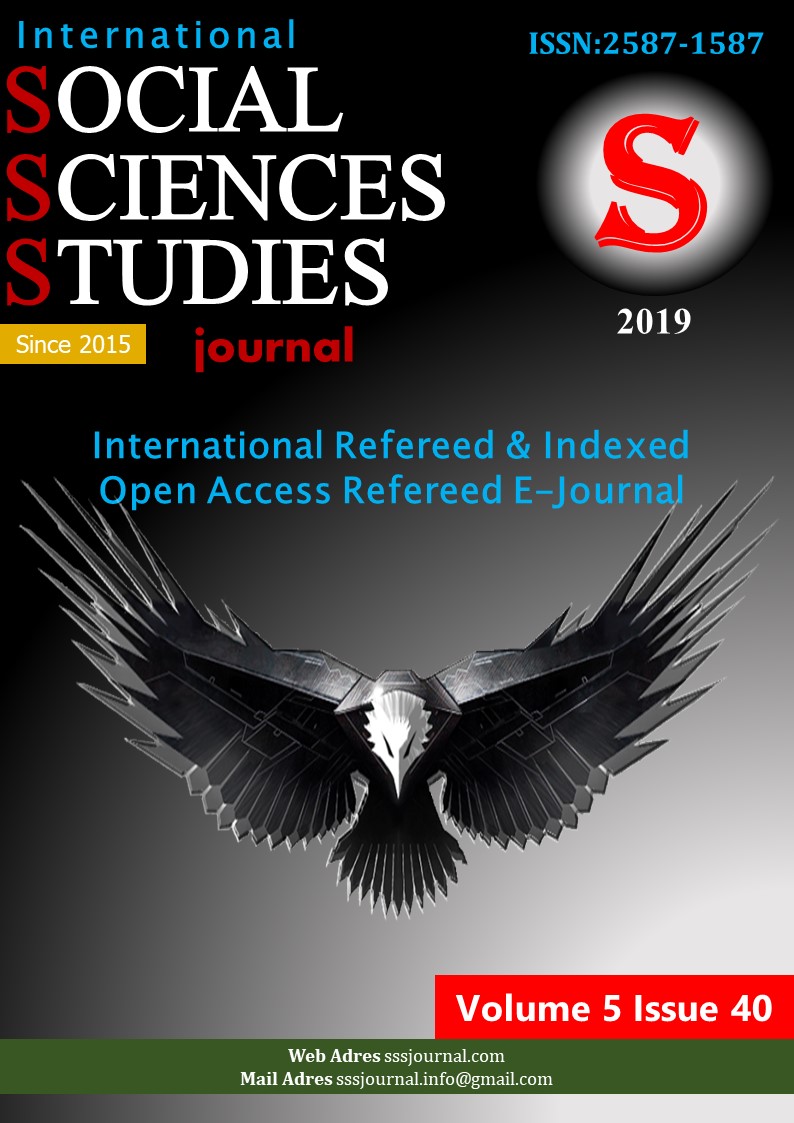A Research On Historical Urban Environments İn The Scope Of The Balance Between Protection And Use: Izmir (Turkey)
Author :
Abstract
Tarihi mekânlar ve anıtlar, geçmişten günümüze kadar farklı dönemlere tanıklık etmiş, kullanıcılarına geçmiş dönemlerdeki toplumsal yaşama dair pek çok bilgiyi aktaran kanıtlardır. Bu eserler çevresel ve toplumsal kimlikten hem etkilenen hem de kimliği etkileyen nitelikte olup, nesiller arası sürekliliği sağlayan önemli elemanlardır. Tarihi çevreler büyük önemlerine karşın, günümüzde hızlı ve çarpık kentleşme, kentsel yaşamdaki ekonomik gelişmeler ve değişim dönemlerin farklı kullanım - teknolojik beklentilerinin ortaya çıkması neticesinde, avantaj yerine dezavantaj olarak algılanmaktadır. Bu etkiler altında tarihi çevrelerin yok edilerek yeni tip yapılaşmanın tercih edilmesi önemli bir sorun durumundadır. Bu kapsamda, tarihi çevrelerin korunmasına yönelik en önemli adımın, bu çevrelerin kent yaşamına dâhil edilerek ekonomik ve kullanım döngüsündeki yerini almasıyla sağlanacağı düşülmektedir. Bu amaçla tarihi çevrelerde kullanma-koruma dengesinin kurulması büyük önem taşımaktadır. Çalışma kapsamında, Kültür ve Turizm Bakanlığı tarafından belirlenen İzmir'in tarihi yerleri ve anıtları araştırılmıştır. Bakanlık tarafından listelenen tüm tarihi yerler incelenirken; Tanımlanan tarihi anıtlar arasında çevresiyle kentsel bir açık alan yaratabilenler çalışma kapsamında araştırma alanlarına dahil edilmiştir. 14 araştırma alt alanı için yerinde gözlem çalışmaları yapılmış ve “görsel etkileşim, fiziksel etkileşim, mekanın etkin kullanımı, bakım - yönetim, kentsel yaşamdaki durum, kentsel kimliğe katkı” gibi veriler elde edilmiştir. Her bir alt alan için elde edilen veriler, İzmir şehrinin tarihi yerleri ve anıtları bağlamında bir bütün olarak değerlendirilmiş ve tarihi kent miraslarını iyileştirmeye yönelik önerilerde bulunulmuştur.
Keywords
Abstract
Historical sites and monuments have witnessed different periods from the past to the present, providing evidence to their users about the social life of the past. These spaces are both influence and influenced by environmental and social identity and are important factors that ensure continuity between generations. Despite their great importance, historical environments are perceived as disadvantages rather than advantages as a result of rapid and distorted urbanization, economic developments in urban life and different usage - technological expectations of change periods. Under these influences, the destruction of historical environments and the preference of a new type of construction is an important problem. In this context, it is assumed that the most important step towards the protection of historical environments will be provided by incorporating these environments into urban life and taking their space in the economic and usage cycle. For this purpose, it is of great importance to establish a balance of use and protection in historical environments. Within the aim of the study, the historical sites and monuments of İzmir, which were determined by the Ministry of Culture and Tourism are researched. While all the historical sites listed by the Ministry are examined; Among the historical monuments identified, those who can create an urban open space with their surroundings were included in the research areas in terms of the scope of the study. On-site observations were conducted for 14 research sub-areas, and data on “visual interaction, physical interaction, effective use of space, maintenance – management, status in urban life, contribution to urban identity” of areas were obtained. The data obtained for each sub-area were evaluated as a whole in the context of the historical sites and monuments of the city of Izmir and suggestions have been given to improve historical urban heritage.
Keywords
- ▪ Arabacıoğlu F. P. & Aydemir I. (2007). “The Concept of Revalorization in Historical Environments”, YTÜ Arch. Fac. E-Journal Volume 2, Issue 4, 204 – 212 p.
- ▪ Arıkan, Z. (2001). “Stori’nin Kemeraltı Planı. İzmir Kent Kültürü Dergisi”, ISSN: 13025988, 4: 76 – 91 s.
- ▪ Embaby, M. E. (2014). “Heritage conservation and architectural education: An educational methodology for design studios’’, Housing and Building National Research Center, HBRC Journal (2014) 10, 339–350.
- ▪ Gündüz, O. & Taner, T. (2002). “Küreselleşme Sürecinde Türk Kentlerinin Kimlik Sorunları ve İzmir Örneği”, 1. Uluslararası Kentsel Tasarım Buluşması, MSÜ, 22 – 29 Eylül 2001, İstanbul, 552 – 562 s.
- ▪ Güngor, S. & Polat, A.T. (2018). “Relationship Between Visual Quality and Landscape Characteristics in Urban Parks”, Journal of Environmental Protection and Ecology, 19 (2), pp. 939 – 948.
- ▪ Guzman, P. C.; Pereira Roders, A. R. & Colenbrander, B. J. F. (2017). “Measuring Links Between Cultural Heritage Management and Sustainable Urban Development: An Overview of Global Monitoring Tools”, Cities, 60 (2017) 192 - 201.
- ▪ Ocak, E. (2006). “An Evaluation About Istanbul’s Historical Parks From the Viewpoint of Nowadays Usage Functions”, Master Thessis, The Graduate School of Natural and Applied Sciences of Istanbul Technical University, 178 p.
- ▪ Özçakır, Ö. (2018). “In- Between Preservation and Economics: Establishing Common Ground Between Socio- Cultural and Economic Values for the Sustainability of Urban Heritage Spaces in Turkey”, Degree of Doctor of Philosophy in Architecture, The Graduate School of Natural and Applied Sciences of Middle East Technical University, 334 p.
- ▪ Polat, Z. & Demirel, O. (2016). “Evaluation of Alternative Tourism in the Light of Natural, Cultural and Visual Resources in Turkey Landscape”. Journal of Environmental Protection and Ecology, 17 (3), pp. 1220 – 1228.
- ▪ Tunçer, M. (1998). “Kentsel Tasarımın Tarihsel Çevre Korunmasında Etkin Olarak Kullanımı, "Böl ve Yönet Modeli": Ankara, Konya, Antalya Tarihi Kent Merkezleri”, 9. Kentsel Tasarım ve Uygulamalar Sempozyumu, “Faklı Ölçeklerde Kentsel Tasarım”, Sunulan Bildiri, Mimar Sinan Üniversitesi, Mim. Fak. Şehir ve Bölge Planlama Bölümü, 21-22 Mayıs 1998.
- ▪ Tweed, C. & Sutherland, M. (2007). “Built Cultural Heritage and Sustainable Urban Development”, Landscape and Urban Planning 83 (2007) 62–69.
- ▪ Umar, B. (2000). “İzmir’in Yaşı. İzmir Kent Kültürü Dergisi”, ISSN:1302–5988, 1:39–41 s.
- ▪ UNESCO, (2011). “Recommendation on the Historic Urban Landscape”, https://whc.unesco.org/uploads/activities/documents/activity-638-98.pdf, Access: 15.04.2019.
- ▪ “Kızılçullu Aqueduct” retrieved from http://arkeolojigezginleri.blogspot.com/2014/08/kizilcullu-su-kemerleri.html
- ▪ “Historical Asansör and Dario Moreno” retrieved from https://www.gezecegiz.com/izmir-gezilecek-yerler/cq8a1992-19/





